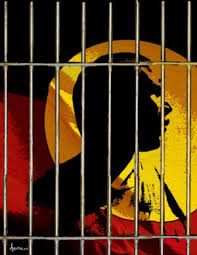Aboriginal Deaths in Custody – A National Disgrace?
In August 2014, Aboriginal woman Julieka Dhu, 22, died while in police custody in Port Hedland, Western Australia. Dhu was arrested and held over for the non-payment of $3,622 in minor fines after calling police to report she was a victim of domestic violence.
Soon after being taken into custody Dhu was taken to the health campus on two separate occasions after complaining of severe breathing pain but was soon released back into custody after being assessed by two doctors who attributed Dhu’s symptoms to “behavioural gain” and/or drug withdrawal and declared her fit to return to custody.
Dhu was finally taken to hospital on a third occasion where shortly after her arrival she went into cardiac arrest and died. A later autopsy revealed that Dhu died from pneumonia and a fatal infection stemming from a previous rib fracture.
The police officers accompanying her to the clinic had told health practitioners that she was ‘faking’ her health complaints.
Dhu is just one case highlighting what many say is an alarming trend in Aboriginal deaths in custody that has been going on for well over 25 years. A 1988 report (Aboriginal Deaths in Custody) by the Australian Institute of Criminology highlighted that at the time of writing their report at least 100 Aboriginals had died in the custody since 1980. A Royal Commission was established in August 1987 after sixteen Aboriginals died in custody during an eight month period. The Commission’s final report on April 1991 revealed that about 340 Indigenous people had died in custody since the investigation into such deaths began. According to Amnesty International spokesman Julian Cleary, “one in five people who die in custody today are Indigenous.”
The report revealed some disturbing facts including: a large proportion of Aboriginals who died in custody were in custody for relatively minor offences, in particular public drunkenness, and the most common cause of death was hanging. According to the National Commission on Correctional Health Care 1987, “alcohol withdrawal is associated with high risk of mortality of those in custody.” So it is not surprising that in its report the Commission recommended that public intoxication and alcohol addiction be handled by community welfare and medical officers and not by police.
Decriminalising public drunkenness and providing alcohol rehabilitation programs would not only serve to control alcohol abuse and addiction, it could also give members of Aboriginal community the support they desperately need instead of being further marginalised by punitive laws.
Critics argue that the disproportionate number of Indigenous people in custody represent an institution of racism because many Aboriginals in custody are in jail for minor offences such as in the case of Ms. Dhu who was incarcerated for unpaid fines.
The report proposed alternatives to imprisonment to reduce the risk of future Aboriginal deaths in custody such as restitution and community service instead of incarceration for minor infractions. As the report suggests, alternatives to imprisonment would also “significantly lower the financial burden to taxpayers.”
The report also suggested training police and prison officers in suicide prevention and crisis intervention might also be an effective way to reduce the risk of Aboriginal deaths in custody.
However, critics like national Indigenous leader Patrick Dodson say the fact that the majority of the commission’s 339 recommendations remain unimplemented or only partially implemented (according to a 2015 report by law firm Clayton Utz) since the recommendations were made over 25 years ago shows a culture in this country that supports Indigenous people being thrown into custodial institutions like they are just “waste.”
For example, one of the key principles of the royal commission’s report was that imprisonment be used as a sanction of last resort. However, many jurisdictions across Australia have mandatory sentencing laws, which a report by Amnesty International says erodes this principle.
Another of the royal commission’s recommendations — an ongoing amnesty for long outstanding unpaid fines — Dhu’s grandmother said could have saved her granddaughter’s life if had been in effect at the time of her incarceration (Source: ABC news).
As Calla Wahlquist wrote in the Guardian, the main finding of the Commission was that Aboriginal people are more likely to die in custody because they are more likely to be in custody. Currently 27% people in custody are Indigenous, almost double the number of Aboriginals incarcerated in 1991. However, they make up only about 3% of the Australian population.
Thus, as the report suggests, the best way to reduce the number of Aboriginal deaths in custody would be for government to address this imbalance in incarceration rates. A good first step might be to implement the Commission’s recommendations that were suggested over a quarter of a century ago, according to Dhu’s uncle, Shaun Harris.
NSW and other states have introduced a few recommendations including: the introduction of an independent mandatory custody notification system, as well as ending the practice of sending people to jail for not paying their fines. That is a start. But is it enough?







